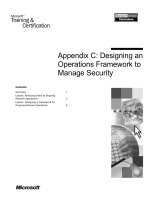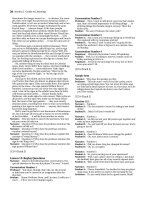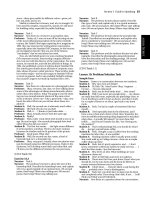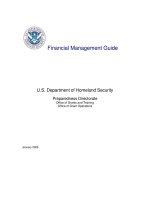Tài liệu Financial Management Guide: U.S. Department of Homeland Security ppt
Bạn đang xem bản rút gọn của tài liệu. Xem và tải ngay bản đầy đủ của tài liệu tại đây (283.22 KB, 63 trang )
Financial Management Guide
U.S. Department of Homeland Security
Preparedness Directorate
Office of Grants and Training
Office of Grant Operations
January 2006
Department of Homeland Security
The mission of the Department of Homeland Security (DHS) is to lead the unified
national effort to secure America; to prevent and deter terrorist attacks and protect
against and respond to threats and hazards to the nation; and to ensure safe and secure
borders, welcome lawful immigrants and visitors, and promote the free-flow of
commerce. DHS is also dedicated to protecting the rights of American citizens and
enhancing public services, such as natural disaster assistance and citizenship services,
by dedicating offices to these important missions.
Department of Homeland Security
World Wide Web page:
U.S. Department of Homeland Security
Preparedness Directorate
Office of Grants and Training
Office of Grant Operations
800 K Street, NW
Washington, DC 20001
Mailing Address
810 Seventh Street, NW
Washington, DC 20531
Michael Chertoff
Secretary
U.S. Department of Homeland Security
Tracy A. Henke
Executive Director
Office of Grants and Training
Kimberly Orben
Director, Office for Business Administration
Office of Grants and Training
Nancy Anne (Baugher) Foy
Director, Office of Grant Operations
Office of Grants and Training
1-866- 9ASK-OGO (866-927-5646)
Foreword
Since terrorists attacked our nation on September 11, 2001, the Office of Grants
and Training (G&T) and its predecessor agencies have awarded more than $8.6
billion in grant funding to build capabilities at the state and local levels to prevent,
prepare for, and respond to terrorist incidents and catastrophic disasters. As
stewards of these public funds, G&T and its recipient agencies share
responsibility for ensuring–through sound planning and prioritizing–that those
funds are well-invested, and–through sound financial processes–that those funds
are well-managed.
G&T’s Office of Grant Operations (OGO) developed this Financial Management
Guide to provide step-by-step guidance in fulfilling your fiduciary responsibility as
recipients of Federal grant funds and in ensuring that these taxpayer dollars are
used for the purposes for which they are awarded. The Guide should serve as
the primary reference and day-to-day management tool for G&T award recipients
and subrecipients in all financial management and grant administration matters.
I hope that you will find this Financial Management Guide useful and welcome
your comments and suggestions. I also encourage you to contact our Office of
Grant Operations whenever you have a question about your financial
management operations or any of the areas covered in this Guide. OGO’s
Customer Service staff may be reached at 1-866-9ASK-OGO or via e-mail at
Thank you for your efforts to strengthen the financial management of your grants,
to safeguard public funds, and to ensure our national security by building state
and local preparedness. I look forward to continuing to work with you.
Tracy A. Henke
Executive Director
Table of Contents
CHAPTER 1: INTRODUCTION 1
WHAT IS THE PURPOSE OF THIS GUIDE? 2
WHO IS THIS GUIDE DESIGNED FOR? 3
CHAPTER 2: THE APPLICATION PROCESS 5
NOTICE OF FUNDING AVAILABILITY/ANNOUNCEMENTS 6
APPLICATION REVIEW 6
TECHNICAL REVIEW 7
COST ANALYSIS 8
CHAPTER 3: THE AWARD PROCESS 9
THE AWARD DOCUMENT 10
ACCEPTANCE OF AWARD AND CONDITIONS 10
TYPES OF FINANCIAL ASSISTANCE: GRANT OR COOPERATIVE AGREEMENT 11
PLANNING AND IMPLEMENTING AWARD PROGRAMS 11
CHAPTER 4: MANAGING FEDERAL FUNDS 12
FINANCIAL MANAGEMENT SYSTEM REQUIREMENTS 13
RECIPIENT AND SUBRECIPIENT ACCOUNTING RESPONSIBILITIES 13
COMMINGLING OF FUNDS 14
MONITORING PROJECT PERFORMANCE 14
CONFLICTS OF INTEREST 15
SUPPLANTING 15
CHAPTER 5: PAYMENTS 17
REQUEST FOR ADVANCE/REIMBURSEMENT 18
WITHHOLDING OF FUNDS 18
CASH MANAGEMENT IMPROVEMENT ACT OF 1990 18
INTEREST 19
CHAPTER 6: OBLIGATION AND EXPENDITURES 20
OBLIGATION OF FUNDS 21
PERIOD OF AVAILABILITY 21
EXPENDITURE OF FUNDS 21
SUSPENSION AND TERMINATION 21
CHAPTER 7: GRANT REPORTING 23
FINANCIAL REPORTING 24
PROGRAMMATIC REPORTING 24
CHAPTER 8: ADJUSTMENTS TO AWARDS 25
MODIFICATIONS AND REVISIONS (INCLUDING GRANT ADJUSTMENT NOTICES) 26
NOTIFICATION OF CHANGES 26
TYPES OF ADJUSTMENTS: 26
CHAPTER 9: OTHER PROGRAM FUNDS 28
PROGRAM INCOME 29
REQUIREMENTS FOR MATCHING OR COST SHARING 30
CHAPTER 10: COSTS AND EXPENDITURES 32
ALLOWABLE COSTS 33
UNALLOWABLE COSTS 36
COSTS REQUIRING PRIOR APPROVAL 38
CHAPTER 11: PROCUREMENT 40
PROCUREMENT STANDARDS 41
SOLE SOURCE PROCUREMENT (NON-COMPETITIVE) 41
CHAPTER 12: AUDITS 43
AUDIT REQUIREMENTS FOR STATES, LOCAL GOVERNMENTS, AND NON-PROFIT ORGANIZATIONS 44
AUDITS OF COMMERCIAL/FOR-PROFIT ORGANIZATIONS 45
AUDITS OF SUBRECIPIENTS 45
DISTRIBUTION OF REPORTS 45
TECHNICAL ASSISTANCE 45
CHAPTER 13: CLOSE OUT 47
CLOSE OUT PROCESS 48
RETENTION AND MAINTENANCE OF RECORDS 48
ACCESS TO RECORDS 49
APPENDIX: GLOSSARY OF TERMS 50
INDEX 56
Chapter 1: Introduction
Highlights from this chapter:
• What is the purpose of this Guide?
•
Who is this Guide designed for?
1
Introduction
What is the purpose of this Guide?
This Guide is intended to be used for the administration of Federal award programs
administered by the Office of Grants and Training (G&T) in conjunction with the
provisions of the Office of Management and Budget (OMB) circulars and government-
wide common rules applicable to grants and cooperative agreements, program
guidelines, application kits, special conditions, terms and conditions, G&T information
bulletins, and DHS policy, regulations and statutes. Details specific to the OMB Circulars
can be found on the OMB website at
www.whitehouse.gov/omb/circulars/. Below is a
list of the most commonly used circulars with which grant recipients should become
familiar.
Administrative Guidelines:
OMB Circular A-102, Grants and Cooperative Agreements with State and Local
Governments. This Circular establishes consistency and uniformity among Federal
agencies in the management of grants and cooperative agreements with State, local,
and Federally recognized Indian tribal governments.
OMB Circular A-110, Uniform Administrative Requirements for Grants and Other
Agreements with Institutions of Higher Education, Hospitals and Other Non-Profit
Organizations. This Circular establishes administrative requirements for Federal grants
and agreements awarded to commercial organizations, institutions of higher
education, hospitals, and other non-profit organizations.
Cost Guidelines:
OMB Circular A-21, Cost Principles for Educational Institutions. This Circular
establishes principles for determining costs applicable to grants, contracts, and other
agreements with educational institutions.
OMB Circular A-87, Cost Principles for State, Local and Indian Tribal Governments.
This Circular establishes principles and standards for determining costs for Federal
awards carried out through grants, cost reimbursement contracts, and other agreements
with State, local and Federally recognized Indian tribal governments.
OMB Circular A-122, Cost Principles for Non-Profit Organizations. This Circular
establishes principles for determining costs of grants, contracts and other agreements
with non-profit organizations. It does not apply to colleges and universities, which are
covered by Office of Management and Budget (OMB) Circular A-21, "Cost Principles for
Educational Institutions"; State, local, and Federally recognized Indian tribal
governments, which are covered by OMB Circular A-87, "Cost Principles for State,
Local, and Indian Tribal Governments"; or hospitals.
Code of Federal Regulations,Title 48 Federal Acquisition Regulations Systems, Chapter
1, Part 31, Contract Cost Principles and Procedures. This part is to be used by
2
commercial organizations and contains cost principles and procedures for cost analysis
and the determination, negotiation and allowance of costs.
Audit Guidelines:
OMB Circular A-133, Audits of States, Local Governments, and Non-Profit
Organizations. This Circular provides requirements regarding audits of State, local and
tribal governments and non-profit organizations (the Single Audit Act), in addition to
the circulars for cost principles. This Circular requires that non-Federal entities that
expend $500,000 (effective January 1, 2004) or more of total Federal funds in their fiscal
year shall have a single or program-specific audit conducted for that year. Guidance on
determining Federal awards expended is provided in
Section 205 of this Circular.
Unless prohibited by law, the costs of audits made in accordance with the provisions of
this requirement are allowable charges to Federal awards. The charges may be
considered a direct cost or an allocated indirect cost, as determined in accordance with
the provisions of applicable OMB cost principles circulars, the Federal Acquisition
Regulation (FAR) (48CFR parts 30 and 31), or other applicable cost principles or
regulations.
For those organizations not subject to the A-133 requirements, records must still be
available and complete for review or audit by appropriate officials or representatives of
the Federal agency, pass-through entity, and Government Accountability Office (GAO).
These organizations shall have financial and compliance audits conducted by qualified
individuals who are organizationally, personally, and externally independent from those
who authorize the expenditure of Federal funds to ensure that there is no conflict of
interest or appearance of conflict of interest.
The cost of auditing a non-Federal entity that has Federal awards expended of less than
$500,000 per year and is thereby exempted under the A-133 requirement may not
charge such costs to their Federal award(s).
Who is this Guide designed for?
This document is provided for the use of all recipients and their subrecipients of Federal
award programs administered by G&T. This Guide is to serve as the primary reference
for financial management and grants administration. Specific organizations and
individuals that are to use this Guide include the following:
Direct Recipients:
Formula and discretionary recipients receiving funds directly from G&T.
Subrecipients:
An individual and/or organization that receives Federal financial or property assistance
through the direct recipient of Federal funds. This may include entities receiving funds as
a result of formula awards. Units of government and other organizations receiving
Federal financial assistance from the State shall adhere to applicable State laws and
procedures except where inconsistent with Federal statutes and guidelines. The
3
circulars and government-wide common rules specific to that organization-type also
apply.
Individuals from the above organizations who may use this Guide include, but are not
limited to: administrators, financial management specialists, grants management
specialists, accountants, and auditors. These individuals are to use the Guide as a
financial policy reference in executing their duties under agency-funded programs and
projects. Additionally, the document is structured to serve as a training manual for new
employees.
This Guide is not for the direct use of contractors. However, direct recipients should
ensure that monitoring of organizations under contract to them is performed in a manner
that will ensure compliance with their overall financial management requirements.
This Guide is intended to be used for fiscal year 2006 and future G&T awards.
Any awards made prior to October 1, 2005 must follow the legacy organization’s
regulations as outlined in the recipient’s award terms and conditions.
Order of Precedence
In determining the relevant standards for the conduct of grant operations, grantees
should consider the following, in precedential order:
• Public Laws
• Regulations
• Executive Orders
• OMB Circulars
• Departmental Policy
• Award Terms and Conditions
4
Chapter 2: The Application Process
Highlights from this chapter:
• Notice of Funding Availability/Announcements
•
Application Review
•
Technical Review
• Cost Analysis
5
The Application Process
Notice of Funding Availability/Announcements
A compilation of available assistance programs may be found in the Catalog of Federal
Domestic Assistance (CFDA) at
www.cfda.gov. G&T grant program announcements
can also be found at the DHS/G&T (
and
Grants.Gov (
www.grants.gov) websites or by contacting the Centralized Scheduling
Information Desk (CSID) at 1-800-368-6498 or
. The websites will
provide you, at minimum, a link to the full application kit and online application system.
The following kinds of information can be found in the program
guidance/solicitation packages for each specific program:
• Authorization
• Objectives
• Use and Restrictions
• Eligibility - Eligible applicants will be detailed in each program
guidance/solicitation package released for funding. Formula funds are generally
awarded to the State Administrative Agency (SAA), which may, in turn, subgrant
funding to units of local government and nonprofit organizations, based upon
statutory authority. (See appropriate specific program guidelines for eligibility.)
Discretionary awards may also be awarded to States, units of local government,
Indian tribes and tribal organizations, individuals, educational institutions,
hospitals, and private nonprofit and private commercial organizations (if
legislation allows) at the discretion of DHS/G&T.
• Match Requirements
• Program Description
• Funding Availability
• Program Specific Requirements
• Application Deadlines
• Application Requirements
• Application Forms
• Reporting Requirements
Application Review
SF 424 Analysis:
G&T examines information contained in the Application for Federal Assistance (SF 424)
to ascertain the following information:
• Employer Identification Number (EIN). This number includes the Social
Security Numbers (SSN) for individuals or employer identification numbers (EIN)
for business entities, which are used to identify our customers.
• Whether an applicant holds a Federal Debt obligation. The SF 424 includes a
question about whether there is Federal debt. That question applies to the
organization requesting the financial assistance, not the person who signs the
6
application as the authorized representative of the organization. This kind of debt
is defined to include delinquent audit disallowances, loans, and taxes.
• DUNS number: All grant applicants must have a Dun & Bradstreet (D&B) Data
Universal Numbering System (DUNS) number in order to apply for Federal
financial assistance. Organizations may receive a DUNS number at no cost by
calling the toll-free DUNS Number request line at 1-866-705-5711. Individuals
who apply for grant awards or cooperative agreements from the Federal
government are exempt from this requirement.
Financial Capability and Fiscal Integrity:
Nongovernmental (non-profit and commercial) organizations that have not previously
received DHS/G&T funds or have not had an active award within 3 years must complete
the Accounting System and Financial Capability Questionnaire. This form is to be
submitted as part of the application package. This Questionnaire may be obtained at
A preliminary assessment of the applicant’s financial capability, including the applicant’s
accounting system and operations, will be completed to ensure that if Federal funds are
awarded the funds will be expended in a judicious manner. Where a nongovernmental
applicant (except public colleges, universities, and hospitals) has never received an
award, the organization’s accounting system will be reviewed prior to award or within a
reasonable time thereafter to assure its adequacy and acceptability. This review may
also apply where known financial or management deficiencies appear to exist. The
results of the review will determine the action to be taken by the awarding agency with
regard to the award, i.e. additional reporting or monitoring requirements. Where an
applicant has had prior awards, outstanding audit issues and delinquent audit, financial,
or progress reports must be resolved prior to awarding additional discretionary funds.
The awarding agency will obtain credit reports before making awards to new recipients
or to those recipients with poor past performance records. Also, the awarding agency
may obtain credit reports on any applicant when there is reason to believe that
performance is substandard or there is evidence of financial irregularities. If this
preliminary assessment indicates that an applicant may be of higher risk, G&T may
impose additional monitoring and/or reporting requirements.
G&T will also take the following information into account when considering the
application for award: 1) past grant history, 2) audit reports, and 3) financial and
performance report submission.
Technical Review
Awards that are made through a competitive review process will undergo a “peer
review”. Applications that meet the minimum requirements identified in the program
guidance will move forward and be reviewed by a panel(s) of subject matter experts.
The subject matter experts will then score and may rank the applications or make
recommendations for funding to G&T.
7
Cost Analysis
G&T may conduct a cost analysis of each project application considered for funding.
This cost analysis includes obtaining cost breakdowns, verifying cost data, evaluating
specific elements of costs, and examining data to determine the necessity,
reasonableness, allowability, allocability, and appropriateness of the proposed cost. The
form and extent of such an analysis will be determined by G&T based on the level and
type of funding. Each program guidance package will specify when/if a cost analysis will
be completed and the type of cost information required.
8
Chapter 3: The Award Process
.
Highlights from this chapter:
• The Award Document
•
Acceptance of Award and Conditions
• Types of Financial Assistance: Grant or Cooperative Agreement
• Planning and Implementing Award Programs
9
The Award Process
The Award Document
After completing the internal review process, project applications designated for approval
are formally awarded through the issuance of an Award Document.
This document includes:
• Name and address of recipient;
• Date of award;
• Project/performance period;
• Vendor/recipient number;
• Amount of Federal funds;
• Award/agreement number;
• Method of payment; and
• Terms and conditions, as appropriate, that the recipient/subrecipient must meet if
the award is accepted.
Notification of the award will be made electronically. Instructions will be provided on how
to accept the award. All correspondence concerning the award should refer to the
designated award/agreement number shown on the Award Document.
Acceptance of Award and Conditions
The Award Document constitutes the operative document obligating and reserving
Federal funds for use by the recipient in executing the program or project covered by the
award. Acceptance of a Federal award of funds means that the grantee agrees to abide
by all applicable laws, regulations, program guidance and special conditions. This
obligation may be voided without further cause if the recipient fails to accept the award in
a timely manner.
All awards will include terms and conditions that include requirements concerning
compliance with this Guide and compliance with the audit requirements. A number of
other standard or special conditions may be attached to the award. Recipients are
urged to carefully review and understand all terms and conditions of the award
prior to award acceptance. Failure to comply with these terms and conditions
may result in disallowance of costs and recovery of funds and/or suspension or
termination of funds and/or award.
Commercial Award recipients receiving grant funding from G&T should be aware of the
additional special conditions placed on these awards. Commercial organizations must
agree not to make a profit as a result of an award and not to charge a management fee
for the performance of an award. Also, commercial organizations must agree to comply
with the Federal Acquisition Regulations (FAR) cost principles and the administrative
requirements of OMB Circular A-110.
10
If a recipient materially fails to comply with the terms and conditions of an award,
whether stated in a Federal statute, regulation, assurance, application, or notice of
award, G&T may take one or more of the following actions, as appropriate in the
circumstances. This authority also extends to the recipient agency.
1. Temporarily withhold cash payments pending correction of the deficiency by the
recipient.
2. Disallow (that is, deny both use of funds and any applicable matching credit for)
all or part of the cost of the activity or action not in compliance.
3. Wholly or partly suspend or terminate the current award.
4. Withhold further awards for the project or program.
5. Take other remedies that may be legally available.
Types of Financial Assistance: Grant or Cooperative Agreement
Grants are awarded to States, units of local government, or private organizations at the
discretion of the awarding agency or on the basis of a formula. Grants are used to
support a public purpose.
Cooperative agreements are awarded to States, units of local government, or private
organizations at the discretion of the awarding agency. Like grants, cooperative
agreements are also used to support a public purpose. Cooperative agreements are
utilized when substantial involvement is anticipated between the awarding agency and
the recipient during performance of the contemplated activity.
Planning and Implementing Award Programs
Planning Prior to Award
Sound planning practices, both before and after grant awards, are critical to the progress
and success of G&T program initiatives. Pre-planning strategies, such as the use of
calendars and tickler files and their use through all planning phases, contribute towards
program success.
It is imperative that G&T grant applicants not wait until they receive an award to start
planning how funds will be spent. Many grant programs require state and local
jurisdictions to develop Homeland Security Strategic Plans, as well as descriptions of
firefighting and emergency response needs, to which all allocations of grant funds must
be tied. (Refer to specific grant program guidelines for requirements.)
All grantees, including subrecipients, should employ pre-planning strategies, to include
such activities as threat and vulnerability assessments, needs assessments, and gap
analyses prior to making application for a grant award. Based upon the results of these
activities, priorities for funding should then be established. Grantees should leverage all
relevant funding and resources from multiple sources wherever possible that will support
and sustain program efforts. Program budgets should be developed in a manner that
maximizes all resources, not restrictive to Federal funding alone, avoids duplication of
spending, will help achieve identified priorities, and will account for expenditures.
11
Chapter 4: Managing Federal Funds
Highlights from this chapter:
• Financial Management System Requirements
•
Recipient and Subrecipient Accounting Responsibilities
• Commingling of Funds
• Monitoring Project Performance
• Conflicts of Interest
• Supplanting
12
Managing Federal Funds
Financial Management System Requirements
All recipients are required to establish and maintain accounting systems and financial
records to accurately account for funds awarded to them. These records shall include
both Federal funds and all matching funds of State, local, and private organizations,
when applicable. State recipients shall expend and account for grant funds in
accordance with State laws and procedures for expending and accounting for their own
funds. Subrecipients of States shall follow the financial management requirements
imposed on them by States, which must comply with the requirements G&T has imposed
on the States.
Funds specifically budgeted and/or received for one project may not be used to support
another without prior written approval of the awarding agency. Where a recipient’s or
subrecipient’s accounting system cannot comply with this requirement, the recipient or
subrecipient shall establish a system to provide adequate fund accountability for each
project it has been awarded.
Where the conduct of a program or one of its components is delegated to a subrecipient,
the direct recipient is responsible for all aspects of the program, including proper
accounting and financial recordkeeping by the subrecipient. Responsibilities include the
accounting of receipts and expenditures, cash management, maintenance of adequate
financial records, and refunding expenditures disallowed by audits.
Recipient and Subrecipient Accounting Responsibilities
• Reviewing Financial Operations - Direct recipients should be familiar with, and
periodically monitor, their subrecipients’ financial operations, records, systems,
and procedures. Particular attention should be directed to the maintenance of
current financial data.
• Recording Financial Activities - The subrecipient’s award or contract
obligation, as well as cash advances and other financial activities, should be
recorded in the books of the recipient in summary form. Subrecipient
expenditures should be recorded on the books of the recipient or evidenced by
report forms duly filed by the subrecipient. Non-Federal contributions applied to
programs or projects by subrecipients should likewise be recorded, as should
any program income resulting from program operations. All financial records
must validate expenditures related to the respective grant(s).
• Budgeting and Budget Review - The recipient should ensure that each
subrecipient prepares an adequate budget on which its award commitment will
be based. The detail of each project budget should be maintained on file by the
recipient.
• Accounting for Non-Federal Contributions - Recipients will ensure that the
requirements, limitations, and regulations pertinent to non-Federal contributions
are applied.
• Audit Requirements - Recipients must ensure that subrecipients have met the
necessary audit requirements contained in this Guide.
13
• Reporting Irregularities - Recipients and their subrecipients shall promptly
notify the awarding agency and the Federal cognizant audit agency of any illegal
acts or irregularities and of proposed and actual actions, if any. Illegal acts and
irregularities include conflicts of interest, falsification of records or reports, and
misappropriation of funds or other assets. Should a recipient become aware of
any criminal activity related to Federal assistance, these criminal acts should be
reported to the appropriate law enforcement agency.
• Debarred and Suspended Organizations - Recipients and subrecipients must
not award or permit any award at any level to any party that is debarred or
suspended from participation in Federal assistance programs.
• Bonding - The awarding agency may require adequate fidelity bond coverage
where the recipient lacks sufficient coverage to protect the Federal government
interest (see OMB Circular A-110, Subpart C, paragraph 21(c) and OMB Circular
A-122). Where the conduct of a program or one of its components is delegated
to a subrecipient, the direct recipient is responsible for all aspects of the program,
including proper accounting and financial recordkeeping by the subrecipient.
Responsibilities include accounting for receipts and expenditures, cash
management, maintaining adequate financial records, and refunding
expenditures disallowed by audits.
Commingling of Funds
Federal agencies shall not require physical segregation of cash deposits or the
establishment of any eligibility requirements for funds that are provided to a recipient.
However, the accounting systems of all recipients and subrecipients must ensure that
agency funds are not commingled with funds from other awards or Federal agencies.
Each award must be accounted for separately. Recipients and subrecipients are
prohibited from commingling funds on either a program-by-program or project-by-project
basis without prior written approval of the awarding agency.
Monitoring Project Performance
Recipient Responsibilities:
A recipient has full responsibility for the conduct of the project or activity supported and
for the results achieved. The recipient must monitor the performance of the project to
assure adherence to performance goals, time schedules or other requirements as
appropriate to the project or the terms of the agreement. The recipient is responsible for
monitoring the activities of and pass-through requirements to any subrecipients.
Federal (DHS/G&T) Responsibilities:
It is DHS/G&T practice to limit involvement between itself and the recipient in the
performance of a project to the minimum necessary to achieve program objectives and
to ensure conformance with requirements of the grant. The Federal role is that of a
partner, where the Government provides the financial assistance and the recipient
carries out the project activities. In the case of a cooperative agreement, substantial
involvement is expected between the Federal agency and the State, local government,
or other recipient when carrying out the activity contemplated in the agreement.
14
Monitoring is a process whereby the programmatic progress and financial and business
management aspects of a financial assistance award are reviewed by assessing
information gathered from program and financial reports, site visits, teleconferences, and
other means. DHS/G&T requires financial assistance recipients to have adequate
management systems to ensure that project objectives are met and funds are spent and
accounted for properly. To the extent possible, financial assistance award monitors rely
on the management systems of the financial assistance recipients to meet project
objectives, comply with award terms and conditions, and account for funds.
Conflicts of Interest
To avoid conflicts of interest, personnel and other officials connected with agency funded
programs shall adhere to the following requirements:
No official or employee of a State or unit of local government or a non-governmental
recipient/subrecipient shall participate personally through decisions, approval,
disapproval, recommendation, the rendering of advice, investigation, or otherwise in any
proceeding, application, request for a ruling or other determination, contract, award,
cooperative agreement, claim, controversy, or other particular matter in which award
funds (including program income or other funds generated by Federally funded activities)
are used, where to his/her knowledge, he/she or his/her immediate family, partners,
organization other than a public agency in which he/she is serving as an officer, director,
trustee, partner, or employee, or any person or organization with whom he/she is
negotiating or has any arrangement concerning prospective employment, has a financial
interest, or has less than an arms-length transaction.
In the use of agency project funds, officials or employees of State or local units of
government and non-governmental recipient/subrecipients shall avoid any action that
might result in, or create the appearance of:
• Using his or her official position for private gain;
• Giving preferential treatment to any person;
• Losing complete independence or impartiality;
• Making an official decision outside official channels; or
• Affecting adversely the confidence of the public in the integrity of the government
or the program. For example, where a recipient of federal funds makes sub-
awards under any competitive process and an actual conflict or an appearance of
a conflict of interest exists, the person for whom the actual or apparent conflict of
interest exists should recuse himself or herself not only from reviewing the
application for which the conflict exists, but also from the evaluation of all
competing applications.
Violations of the conflict of interest standards may result in criminal, civil, or
administrative penalties.
Supplanting
Recipients of G&T funds shall not replace funding appropriated from State and local
governments with their Federal grant funding. It is the purpose of these grants to
increase the overall amount of resources available to any G&T funded organization in
order to bolster preparedness and to increase services and opportunities. Current levels
15
of activities or programs funded by State, local or non-governmental entity resources
should only be increased by receipt of Federal funding. Recipients therefore must
ensure that they do not reduce the current overall level of funding support to
preparedness missions, absent exigent circumstances.
For example, if a State pays the salaries of three intelligence analysts, it cannot begin to
pay the salary of one of them with Federal grant funding. It could, however, hire a fourth
analyst.
Potential supplanting will be the subject of application review, as well as pre-award
review, post-award monitoring, and audit. If there is a potential presence of supplanting,
the applicant or grantee will be required to supply documentation demonstrating that the
reduction in non-Federal resources occurred for reasons other than the receipt or
expected receipt of Federal funds.
A confirmation during the application process may be requested by the awarding agency
or recipient agency stating that Federal funds will not be used to supplant State or local
funds.
16
Chapter 5: Payments
Highlights from this chapter:
• Request for Advance or Reimbursement
•
Withholding of Funds
•
Cash Management Improvement Act of 1990
• Interest
17
Payments
The method used to request grant funds may be different depending on the grant
program. Information on how to access grant funds is provided to grant recipients in the
program guidance and/or post award instructions. For assistance in determining the
method to be used for payment requests, please contact the Office of Grant Operations
at
1-866-9ASK-OGO or
Request for Advance/Reimbursement
Recipient organizations generally request funds based upon immediate disbursement
requirements. Funds will not be paid in a lump sum, but rather disbursed over time as
project costs are incurred or anticipated. Recipients should time their drawdown
requests to ensure that Federal cash on hand is the minimum needed for disbursements
to be made immediately or within a few days. Beginning with fiscal year 2005 funds,
recipients may elect to drawdown funds up to 120 days prior to
expenditure/disbursement. G&T strongly encourages recipients to draw down funds as
close to expenditure as possible to avoid accruing interest.
Fund requests from subrecipients create a continuing cash demand on award balances
of the State. The State should keep in mind that idle funds in the hands of subrecipients
will impair the goals of sound cash management. All recipients must develop procedures
for the disbursement of funds to ensure that Federal cash on hand is kept at a minimal
balance.
Withholding of Funds
G&T may withhold payments to a recipient organization after proper notification or
opportunity to remedy, by demonstrating any of the following:
1. Unwillingness or inability to attain program or project goals or to establish
procedures that will minimize the time elapsing between cash drawdowns and
expenditures;
2. Inability to adhere to guideline requirements or special conditions;
3. Improper award and administration of subawards or contracts; and
4. Inability to submit reliable and/or timely reports.
Cash Management Improvement Act of 1990
The Cash Management Improvement Act (CMIA) provides the general rules and
procedures for the efficient transfer of Federal financial assistance between the Federal
government and the States. Under this Act, States are no longer exempt from payment
of interest to the Federal government resulting from drawing down funds prior to the
need to pay off obligations incurred. States must pay interest in the event that the States
draw down funds before the funds are needed to pay for program expenses.
Please note: Although recipients may draw down funds up to 120 days in advance of
expenditure, State grantees are still subject to the interest requirements of the
18
CMIA and its implementing regulations at 31 C.F.R. Part 205. Interest under CMIA will
accrue from the time Federal funds are credited to a State account until the time the
State pays out the funds to a subgrantee or otherwise expends for program purposes.
Recipients should request funds based on an immediate cash needs basis.
Interest
Recipients and subrecipients shall minimize the time elapsing between the transfer and
disbursement of funds.
1. A State, its subrecipient and any agency or instrumentality of a State, including
State institutions of higher education and State hospitals, but not political
subdivisions of a State (cities, towns, counties, and special districts created by
State law) SHALL NOT be held accountable for interest earned on grant money
pending its disbursement for program purposes. This refers to formula grant
programs where subawards are made to local jurisdictions. Subrecipients under
formula grant programs are held accountable for interest earned on advances.
2. Tribal organizations SHALL NOT be held accountable for interest earned
pending their disbursement by such organizations.
3. All local units of government (political subdivisions of a State, including cities,
towns, counties and special districts created by State law) shall account for
interest earned on Federal funds. Local units of government may keep interest
earned on Federal grant funds up to $100 PER FEDERAL FISCAL YEAR. This
maximum limit is not per award; it is inclusive of all interest earned as a result of
all Federal grant program funds received per year.
4. Nonprofit and commercial organizations shall account for interest earned on
Federal funds. Nonprofit organizations may keep interest earned on Federal
grant funds up to $250 PER FEDERAL FISCAL YEAR. This maximum limit is
not per award; it is inclusive of all interest earned as a result of all Federal grant
program funds received per year.
For G&T grants, interest earned, in excess of the amounts stated above, must be
remitted to the United States Department of Health and Human Services, Division of
Payment Management Services, P.O. Box 6021, Rockville, MD 20852.
For Assistance to Firefighters Grants (AFG) grants, interest should be remitted to the
FEMA-Accounting Services Division, Disbursements and Receivables Branch, 500 C
Street, S.W., Room 723, Washington, D.C. 20472.
19









